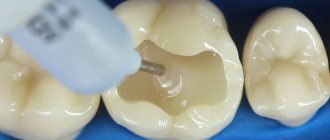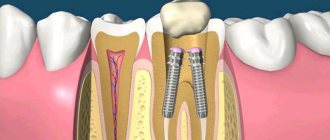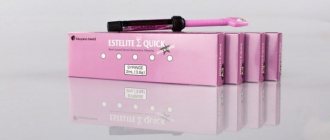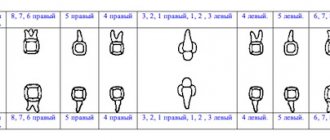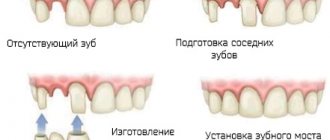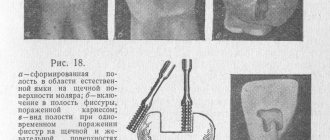After installing a filling, artistic restoration with composite materials, or professional cleaning, teeth must be polished.
The tasks in each case are different, but the meaning is the same: to make the surface as smooth as possible, to remove microcracks, the smallest protrusions and grooves. The smoother the surface, the fewer bacteria there are, which means the lower the risk of infections and inflammation in the oral cavity.
- When used:
polishing restorations and fillings; after hygiene - Treatment period:
as needed - Type of anesthesia:
not required - Procedure time:
up to 40 minutes - Age restrictions:
from 18 years old (in our clinic)
Goals of the procedure
Composite restorations are polished to prevent the accumulation of bacteria in small cracks, and fillings are polished to smooth the transition between it and dentin and correct microdefects.
Grinding and polishing the enamel is the final stage of hygienic teeth cleaning and plaque removal. After the teeth are freed from deposits, their surface becomes rough, and microcracks appear in the dentin. This is a guarantee that plaque will form again and quite quickly. Polishing your teeth after brushing removes minor defects and remaining mineral deposits, preventing the formation of stone.
Polishing the filling
Grinding and polishing the filling is the final stage of tooth restoration. The aesthetic appearance of the restoration depends on it. The final processing of composite filling material is carried out immediately after its application, but dentists recommend performing it the next day after the manipulations. You can grind both old and newly installed fillings. Modern dental clinics offer clients the opportunity to take advantage of new possibilities for finishing fillings. They use new materials that allow the procedure to be completed in just 10-15 minutes.
Why do you need to polish a filling?
Professional teeth cleaning in a dental office ensures the removal of deposits: plaque, stone, interdental dirt. But even after these procedures, the surface of the units may not be ideal. Microcracks, depressions, and grooves may be observed on them. These injuries are small, invisible, and do not pose a danger. However, after the first meal, deposits will begin to accumulate in them. So, cleaning essentially becomes useless.
Polishing the filling: before/after
A similar problem can occur after installing a new filling material that is not smooth. If it is not polished, it will cause discomfort and after a while secondary caries will begin to develop.
Indications and contraindications
The procedure for leveling and polishing tooth enamel is advisable in the following cases:
- Before preparing for oral surgery (as a preventive measure).
- Before prosthetics, to bring the color of the prosthesis as close as possible to the shade of the enamel of the “native” teeth.
- After removing braces, deposits and plaque actively accumulate around the locks, under which dental glue remains.
- After installing the filling for the purpose of adjustment - so that it does not interfere. Sometimes for polishing existing filling material.
Among the contraindications, it is worth noting periodontal disease, periodontitis, enamel hypersensitivity, the presence of wounds, inflammation, and damage in the oral cavity. Also caries. Allergy to medications used during the procedure.
Types of polishing and tools for its implementation
The main tools of a dentist are drill attachments and special pastes. The rotation of the nozzles is carried out at a speed of 2000 to 5000 rpm. In this case, the enamel does not heat up and damage.
Each type of nozzle has its own specific purpose. Rubber cups – for leveling flat surfaces of crowns. Cone-shaped - for eliminating growths, bumps and polishing the chewing area. Strips coated with diamond strips (crumbs) - for grinding interdental spaces.
Polishing a filling: tools
Pastes have different degrees of abrasion. To remove stone-like deposits and filling material, dentists use a blue paste with large particles. Green is aimed at combating small irregularities in the enamel. Red paste is used for final leveling. Yellow ones are suitable for people with sensitive enamel.
The most common polishing method is mechanical. But it does involve the use of attachments and pastes. Dentists also use a drill. But there are other types. They are used mainly by private dental clinics, while mechanical ones are mostly used by public ones.
Ultrasonic method. The filling is exposed to waves of different frequencies, which have a polishing effect. Sandblasting (involves the use of an apparatus that supplies air to the dental units) with a polishing effect. Laser polishing of enamel is also popular. This method guarantees a perfectly smooth surface and disinfection.
Preparation for polishing the filling and carrying out the procedure
To make it convenient for the dentist to work, an expander is placed in the patient’s mouth. It is important not to injure soft tissues with attachments; cotton swabs, which the dentist also places in the space between the gum and cheek, will help with this. To protect the eyes from small particles spreading, the patient wears special glasses. Next, the doctor determines how sensitive the elements of the dentition are, and then selects attachments and types of pastes. The paste is placed in a signet ring holder, then the machine gradually delivers it to the treatment area.
Tooth enamel polishing is performed sequentially:
- Flat surfaces.
- Chewing zone.
- Spaces between teeth.
The manipulations are repeated twice. First with coarse paste. The second treatment is with fine-grained paste.
Despite the absence of restrictions on the patient's contraindications, after polishing the enamel, he receives recommendations for quick rehabilitation. After the session, you may experience an unpleasant taste in your mouth. This phenomenon is temporary.
Important information. Many people are interested in whether the procedure is painful or not. Enamel polishing using any method is carried out without anesthesia. It is absolutely painless and lasts a maximum of half an hour. During the session, an extra-soft abrasive with silica and rubber cups and cone-shaped brushes is used. Dentists recommend smoothing the surface of teeth every six months.
How to care for polished teeth
First of all, it is advisable not to eat food containing dyes for three days after polishing the enamel. You need to not eat or drink anything hot or cold for several days. Buy a toothbrush with soft bristles, especially if you have hypersensitive teeth. It is not recommended to use toothpaste with a whitening effect as it contains abrasive particles. The enamel, therefore, will undergo their influence; you should not damage it again, otherwise it will completely darken. You need to avoid smoking for at least a week.
Expert advice. If you smoke, but want your enamel to not turn yellow or darken after polishing and/or whitening, get rid of the bad habit. Coffee and tea practically do not change its color, but nicotine does. No matter how much you polish and whiten your fillings and teeth, if you smoke, at least once a year, in this case you will have to visit the dentist’s office to remove the yellowness.
If you want your tooth enamel to be smooth, polished, without depressions and cracks in which deposits accumulate, make an initial appointment with your dentist. Take care of your teeth, get examined by a dentist once a year, and your teeth will be healthy and your smile will be “Hollywood.” To get started, you can get a consultation by phone.
Are there any contraindications
There are no contraindications for polishing teeth, but procedures that precede this do have them.
For ultrasonic cleaning:
- presence of a pacemaker;
- treatment with immunosuppressants and corticosteroids;
- recent eye surgery;
- epilepsy;
- severe form of diabetes.
For AirFlow:
- taking medications for salt balance;
- hepatitis;
- AIDS;
- sodium-free diet;
- lung diseases, asthma.
In case of infections, diseases of the upper respiratory tract, exacerbation of general conditions, or the presence of ulcers in the mouth, it is worth postponing resurfacing until the condition improves.
Glass ionomer cement
The most durable and resistant to various influences fillings are created from the most modern materials. Many dentists consider glass ionomer cement to be the best. It is suitable not only for making permanent fillings, but also for fixing dentures and for sealing root canals. In this case, of course, different brands of this material are used.
Glass ionomer cement releases fluoride during its hardening process, which helps destroy bacteria that cause caries. In addition, fillings made from it have an impeccable appearance from an aesthetic point of view, without standing out against the background of natural dental tissue.
What is used
After removing plaque with ultrasound or an air-abrasive device (AirFlow), the dentist begins grinding the teeth.
For this we use:
- Special polishing attachments.
Rubber cups are filled with abrasive paste and all surfaces are thoroughly treated. To treat the tooth crown after the cup, brushes are used. - Strips.
To polish between the teeth, dental tapes (strips) are used. They do this very carefully, trying not to damage the gums. - Abrasive pastes.
To enhance the abrasive effect, use: - Zircon:
an abrasive that perfectly removes age spots and yellowness in smokers. - Silicon dioxide:
suitable for post-scaling polishing, fillings and artistic restorations - Aluminum hydroxide:
depending on particle size, used for both plaque removal and final polishing - Titanium dioxide:
polishes enamel and closes tubules in dentin
Phosphate cement
Although dentistry and construction have very little in common, they are united by the use of the same material. This is phosphate cement, the distinctive feature of which is high adhesion, that is, the ability to “stick” to the surface. Initially, this material is a powder, which is then mixed with liquid.
Dentists use several different brands of phosphate cement, which differ in their hardening time and strength characteristics. The advantages of these materials include their ability to reliably isolate tooth tissue, moderate expansion with increasing temperature and the complete absence of any toxic effects on the body.
At the same time, the low resistance of phosphate cement to mechanical damage and its relatively high solubility in water limit the use of this material for fillings.
Is the filling in the way? Don't be patient!
Has it ever happened that the doctor treated your tooth, put a filling, and when you came home, you felt that the filling was too high, there was discomfort when closing your mouth, and the rest of your teeth did not close?
Unfortunately, this situation occurs quite often. After placing the filling, the doctor polishes it according to the bite: gives the patient a carbon copy to bite, asks if the filling is in the way, adjusts it and polishes it. However, even an extra millimeter of filling, invisible to the doctor’s eye, can be felt by the patient as something foreign on the tooth and cause discomfort. While local anesthesia is in effect and the feeling of numbness remains, it is difficult for the patient to determine whether the filling is in the way. Only when the anesthesia finally wears off does the patient realize that it is inconvenient for him to close his teeth.
In such cases, many people think: “Nothing, it will wear off over time, I’ll get used to it!” Under no circumstances should you endure and wait for the filling to “settle down”, wear off, etc. Modern filling materials are very durable and resistant to abrasion. It can take years for the extra millimeter of filling to wear off. You shouldn’t get used to discomfort either, because... overestimation of the tooth can lead to negative consequences. It is also important that the filling does not block the movements of the lower jaw. You can check this this way: close your teeth, try to move your lower jaw left, right, forward (without opening your mouth wide). If the movements are the same as before the filling was placed, then everything is fine. If you feel that the filling prevents you from moving your lower jaw in any direction, be sure to inform your doctor about this.
How do we do this?
Our specialists will painlessly, efficiently and reliably carry out re-filling. The doctor will select the color and model the shape of the new filling. Filling materials are like paints in an artist’s palette: they can be selected individually for a specific case, for each person, and the color, brightness and transparency of the tooth can be very carefully adjusted. Filling occurs in layers, taking into account the anatomical features of the tooth. As a result, the work of a dentist is not noticeable to others.
Nowadays, the latest filling materials are widely used for dental treatment, which help to cope with several tasks at once - therapeutic, aesthetic and preventive. Their number is growing from year to year, and the quality is improving, which allows us to do better and better work.
However, remember, dear patients, that not in all cases you can limit yourself to replacing the filling. If the destruction process is too advanced, you will be offered a ceramic orthopedic inlay or crown instead of a filling. These materials are more reliable and durable, and will help extend the life of your tooth for a long time. In any case, after a preliminary consultation, our specialists will be able to choose the best option for you.



